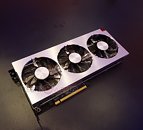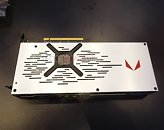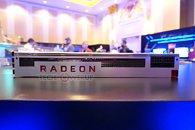Wednesday, January 9th 2019

AMD Radeon VII Hands On at CES 2019
While many have watched or at the very least seen our coverage of AMD's live stream at CES 2019, it just can't compare to seeing the latest graphics card from the company up close and personal. Therefore as soon as we had the opportunity, we took a closer look at the AMD Radeon VII and let us just say the reference card is indeed a bit fancy. The shroud itself is made of metal and has a very similar look and feel to the one used on the Radeon RX Vega 64 liquid cooled reference cards. However, instead of using an AIO for this release AMD instead opted for three uniform fans and a massive heatsink. Not only does this make the card more compatible with small form factor systems, it is also less of a hassle to install. Display outputs consist of 3x DisplayPort and 1x HDMI. Sadly AMD did not include a VirtualLink port (USB Type-C) like NVIDIA for VR headsets, which is rather odd considering AMD is also part of the VirtualLink consortium.
Power delivery is handled by two 8-pin PCIe power connectors giving the card access to a theoretical limit of 375-watts which is 75-watts more than its 300-watt TDP. Considering the Radeon VII has the same power level as the Vega 64 it offers 25% more performance at the same power level. Compute unit count falls between the Vega 56 and Vega 64 at precisely 60 CUs. That said, a few missing CUs are of no consequence when you consider how close the Vega 56 performed to the Vega 64 once tweaked. As for clock speeds AMD has stated the Radeon VII will have a 1.8 GHz core clock, while the 16 GB of HBM2 will deliver 1 TB/s of memory bandwidth over the 4096-bit memory interface.Overall gaming performance is 29% higher according to AMD with the Radeon VII having been tested in 25 titles in order to reach that conclusion. Eight of them were DX12 and two of them Vulkan meaning they used a decent spread of games across multiple APIs. In regards to the games tested they used; Assassin's Creed Odyssey, Battlefield 1, Battlefield V, Destiny 2, Doom, F1 2018, Fallout 76, Far Cry 5, Forza Horizon 4, Grand Theft Auto V, Strange Brigade, The Witcher 3, and Monster Hunter World just to name a few. Add that to the information shown in AMD's graphs and it appears it really can beat or at least trade blows with NVIDIA's GeForce RTX 2080. However, before jumping to any conclusions we will verify that soon enough once we have a sample in for review. In regards to pricing and availability it was already revealed earlier that AMD's Radeon VII will release at $699 on February 7th and will come bundled with a few games including, Devil May Cry 5, Resident Evil 2 and The Division 2 for a limited time.
Power delivery is handled by two 8-pin PCIe power connectors giving the card access to a theoretical limit of 375-watts which is 75-watts more than its 300-watt TDP. Considering the Radeon VII has the same power level as the Vega 64 it offers 25% more performance at the same power level. Compute unit count falls between the Vega 56 and Vega 64 at precisely 60 CUs. That said, a few missing CUs are of no consequence when you consider how close the Vega 56 performed to the Vega 64 once tweaked. As for clock speeds AMD has stated the Radeon VII will have a 1.8 GHz core clock, while the 16 GB of HBM2 will deliver 1 TB/s of memory bandwidth over the 4096-bit memory interface.Overall gaming performance is 29% higher according to AMD with the Radeon VII having been tested in 25 titles in order to reach that conclusion. Eight of them were DX12 and two of them Vulkan meaning they used a decent spread of games across multiple APIs. In regards to the games tested they used; Assassin's Creed Odyssey, Battlefield 1, Battlefield V, Destiny 2, Doom, F1 2018, Fallout 76, Far Cry 5, Forza Horizon 4, Grand Theft Auto V, Strange Brigade, The Witcher 3, and Monster Hunter World just to name a few. Add that to the information shown in AMD's graphs and it appears it really can beat or at least trade blows with NVIDIA's GeForce RTX 2080. However, before jumping to any conclusions we will verify that soon enough once we have a sample in for review. In regards to pricing and availability it was already revealed earlier that AMD's Radeon VII will release at $699 on February 7th and will come bundled with a few games including, Devil May Cry 5, Resident Evil 2 and The Division 2 for a limited time.







109 Comments on AMD Radeon VII Hands On at CES 2019
Lovely that veryone understands what 2080's performance actually is, now that AMD announced V7.... /grins
also my school laptop is 8th gen intel UHD 620 graphics and 768p, and i think Wizard of Legend indie game looks and plays amazing on it at 60 fps. some genres do very well at 60 fps and don't benefit at all.
its so amazing how we can have options! no i must be rigid and believe in one thing like the rest of you! so neat!
I don't even know if there's any benefit above 120. Back in the day on my high end CRT, 120 fps at 120 hz was perfect (of course that's FAR superior to LCD).
all data are from footnotes ( go to bottom of page and then click footnotes ):
www.amd.com/en/press-releases/2019-01-09-amd-unveils-world-s-first-7nm-gaming-gpu-delivering-exceptional
EDIT OFF TOPIC:
Found this strange looking chip. Not sure what this is.
fuse.wikichip.org/news/1833/a-look-at-necs-latest-vector-processor-the-sx-aurora/2/
On topic: More tech specs about the VII here - videocardz.com/newz/amd-shares-more-details-on-radeon-vii
Same performance as 2080 BUT nothing new, really only upp the memory to 16GB.
Prices of the 2080 will be just about the same as Radeon VII at release.
At same price what would you choose, RTX 2080 with RayTracing, DLSS and AI
OR
Radeon VII, revamped old VEGA with really nothing new, only 8GB more memory
In games with DLSS the 2080 will make the Radeon VII suck it's tailpipe with 25-35% higher frame rates.
Also if Radeon VII even come close to affecting the 2080 sales nvidia will instantly drop the price to counter.
Really do not see an upside for AMD in this battle at the moment with Radeon VII
If they did RADEON VII with 8GB memory at 499 USD, that would really make a splash in the graphics market.
As is now i feel that AMD just is trying to align it self with nvidias RTX overprices with essentially shrinked old VEGA tech
Let's not do what fanboys do and say this card isn't for anyone just because me and you don't plan to get one ;)
VW also owns Lamborghini, Bentley, and Bugatti, makers of the VEYRON, the best automotive comparison to a RTX titan.
VW doesnt soly exist as a low end car maker, they have tons of super high margin cars too. AMD cant survive just on the "peoples GPU", thats what they tried with polaris, and while it gained them market share, it didnt give them profit. Nvidia, OTOH, got one silver platter after another full of $$$$.
Hell, this card wouldn't even exist if it wasn't for AMD having a stream of faulty chips from their professional card output.
The fact that it's a 60 proc GPU and not a 56 one, speaks volumes on how well that 7nm process is performing - AMD didn't joke about that.
Anyhow, the way the Vega architecture is designed does not allow them to install less than 16GB 4096bit HBM2 on the GPU package.
Compared to Vega 64's $499 pricing, the $699 price tag is fair as this 40% increase gives you 30% more performance and twice the memory, which while not exactly needed at the moment does make the card future proof. People scoffed at R390(X)'s 8 gigs of VRAM back in 2015, but that card is still a capable performer at 1080p and 1440p well over 3 years later.
Also AMD have finally released a card with proper, premium, air-cooled design, meaning for once people don't have to wait on Sapphire to release their treatment to get the good stuff. So yeah, this thing is really worth the money.
As for whether it's a better choice than RTX 2080, the answer is ofc - it depends.
If you want RT reflections (or shadows, or global illumination - whatever the game in question has, but note that you get only one of these) you will have to forget about native 4K gaming. Obviously at this price level we are not talking about any lower resolutions than that. DLSS is supposed to balance this issue by upscaling 1440p to 4K without loss in quality, but it doesn't work like that because high quality textures get the middle finger in said scenario no matter what.
So it comes down to this - do you want the best textures or the best reflections/etc. at 4K? I can tell you that for me the textures win every time as they contribute to image quality the most (after the resolution itself ofc), while screen space reflections are so good at this point that you can hardly tell the difference in actual gameplay.
So you ain't right mate - plenty of upsides right there. Indeed I'd actually shell the cash for the damn thing if I didn't have a Vega 64 already (which I would have passed on if AMD didn't deny Radeon VII's existence so vehemently up until CES, but oh well - it's marketing, I get it lol).